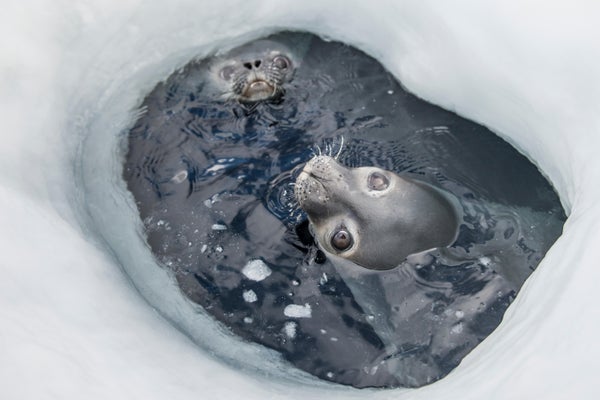Above the frozen ocean, Antarctica can be eerily quiet. Gusts of wind are often all one hears. Below, though, the Southern Ocean is a living soundscape dominated by Weddell seals. These pinnipeds typically emit high-pitched pings that sound like laser guns in a science-fiction movie. But that is not their entire repertoire. Research now reveals that a significant portion of their calls are at ultrasonic frequencies, high pitches well beyond the 20-kilohertz limit of most human hearing.
University of Oregon marine biologist Paul Cziko installed a livestreaming audio and video system at Antarctica’s McMurdo Station in 2017, allowing scientists to listen in on the massive mammals’ underwater calls. Data from the setup yielded surprising results: The seals sometimes vocalized at extremely high, ultrasonic frequencies of more than 200 kilohertz, Cziko and his colleagues reported in the Journal of the Acoustical Society of America.
On supporting science journalism
If you're enjoying this article, consider supporting our award-winning journalism by subscribing. By purchasing a subscription you are helping to ensure the future of impactful stories about the discoveries and ideas shaping our world today.
Ultrasonic calls cast a narrower, more precise sound beam than lower-frequency ones. Bats and toothed whales have specialized anatomy that lets them use such beams for echolocation, sensing their surroundings by deciphering the rebounding sound waves. Seals, however, lack the necessary anatomical structures. So why do they make these sounds?
With true echolocation ruled out, Cziko and his colleagues suspect Weddell seals use ultrasonic calls for less specific orientation purposes. In the early 1970s, William Schevill and William Watkins, both at the Woods Hole Oceanographic Institution, came to a similar conclusion after using the era’s limited technology to record Weddell seals’ ultrasonic vocalizations, likely for the first time. “We have no evidence for echolocation [in Weddell seals], yet it seems that a directional sound beam would be especially useful in echolocation,” they wrote in Antarctic Pinnipedia.
Cziko notes the 1970s team only recorded one call type, a chirp that started at 30 kilohertz and then descended in frequency. With the new system’s advanced hydrophone, Cziko’s team was able to record Weddell seals making at least nine call types spanning the ultrasonic range, including chirps, trills and “U-shaped whistles.” In two years’ worth of recording, 17 percent of all Weddell seals’ calls were ultrasonic, with the animals using this range more often during the Southern Hemisphere winter.
Annual sunlight cycles may play a role in the seals’ seasonal call behavior. Antarctica experiences four months of 24-hour sunlight during summer, and winters have long periods of complete darkness. “We know that seals have really good low-light vision,” says Lisa Munger, a marine mammal bioacoustician at the University of Oregon and a co-author of the new research. “But when there’s no light, they’ve got to be using something else to find their way around.” Echoes from ultrasonic calls may provide enough basic environmental information to help seals return to breathing holes in the ice or to locate food—even if their sound-processing is not specialized enough to be called true echolocation.
High-frequency vocalizations travel shorter distances than lower-frequency ones, and this may also help Weddell seals communicate without alerting predators. “These sounds might be really useful if you’re trying to communicate with someone that’s a few feet away,” Munger says. “But you don’t want the sound to get out into the open water, where there are killer whales.”
Peter Tyack, an animal behaviorist at the Woods Hole Oceanographic Institution and the University of St. Andrews in Scotland, who was not involved with the study, notes another possible communication hypothesis. “If you have territorial males broadcasting threats to each other and you just hear the low-frequency [calls], you might interpret that as a background threat,” he says. “But if all of the sudden you hear the high-frequency … that could mean ‘I’m threatening you, not the general world.’”
The new findings may have a simpler explanation, Tyack adds. Humans define “sonic” and “ultrasonic” ranges based on the limits of our own hearing, but for Weddell and other seals, a range of about 50 to 100 kilohertz may be optimal. As he puts it: “Why would you not make sounds in the best range of your hearing?”
